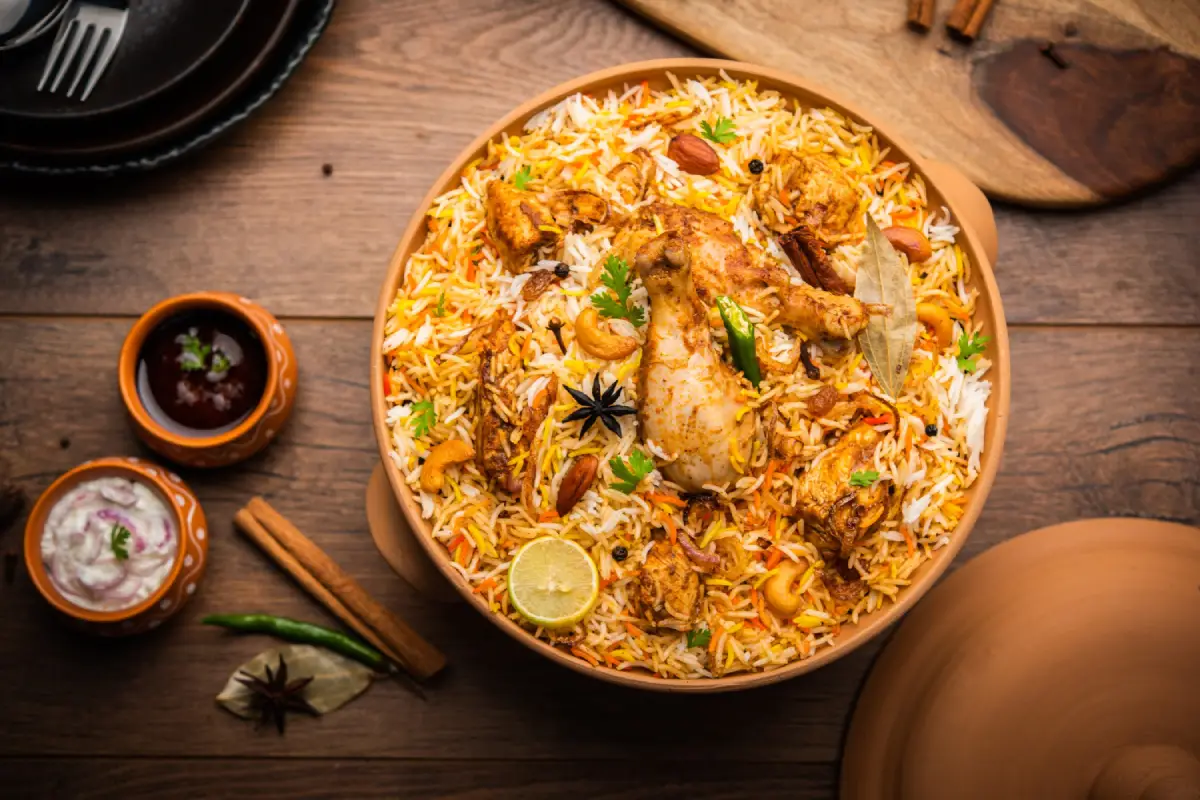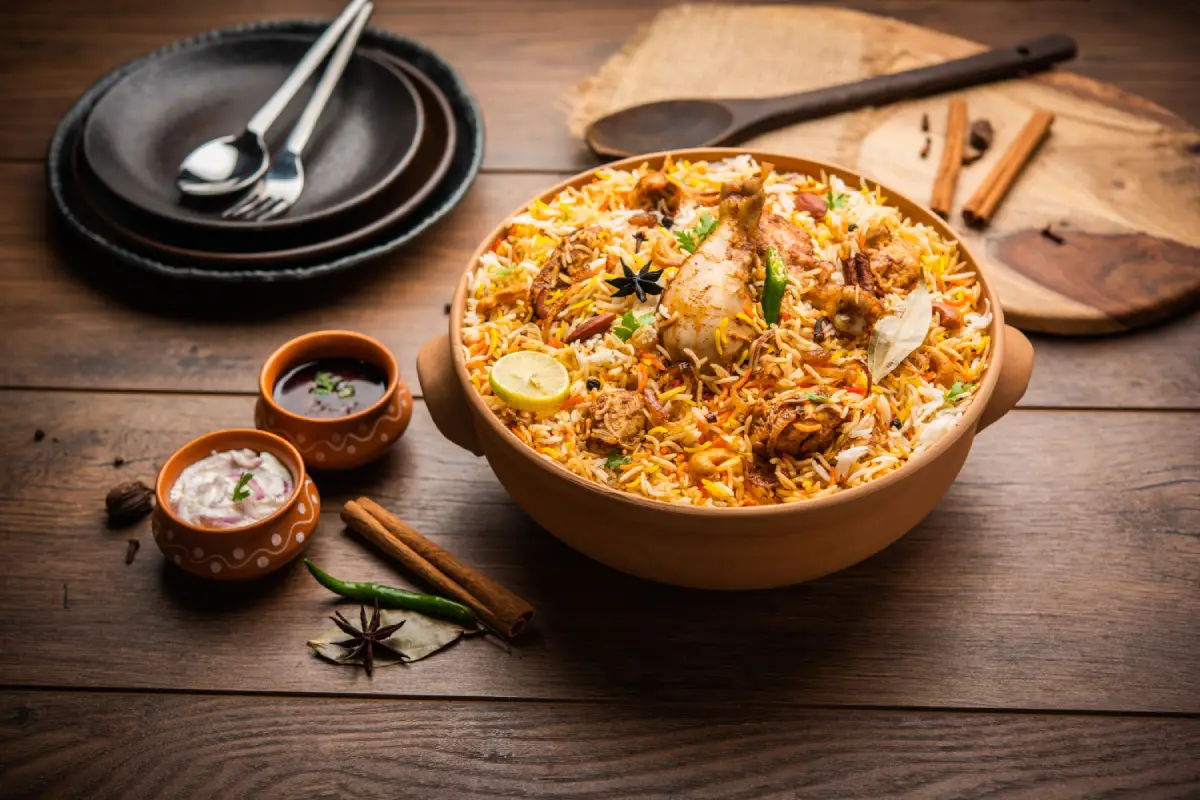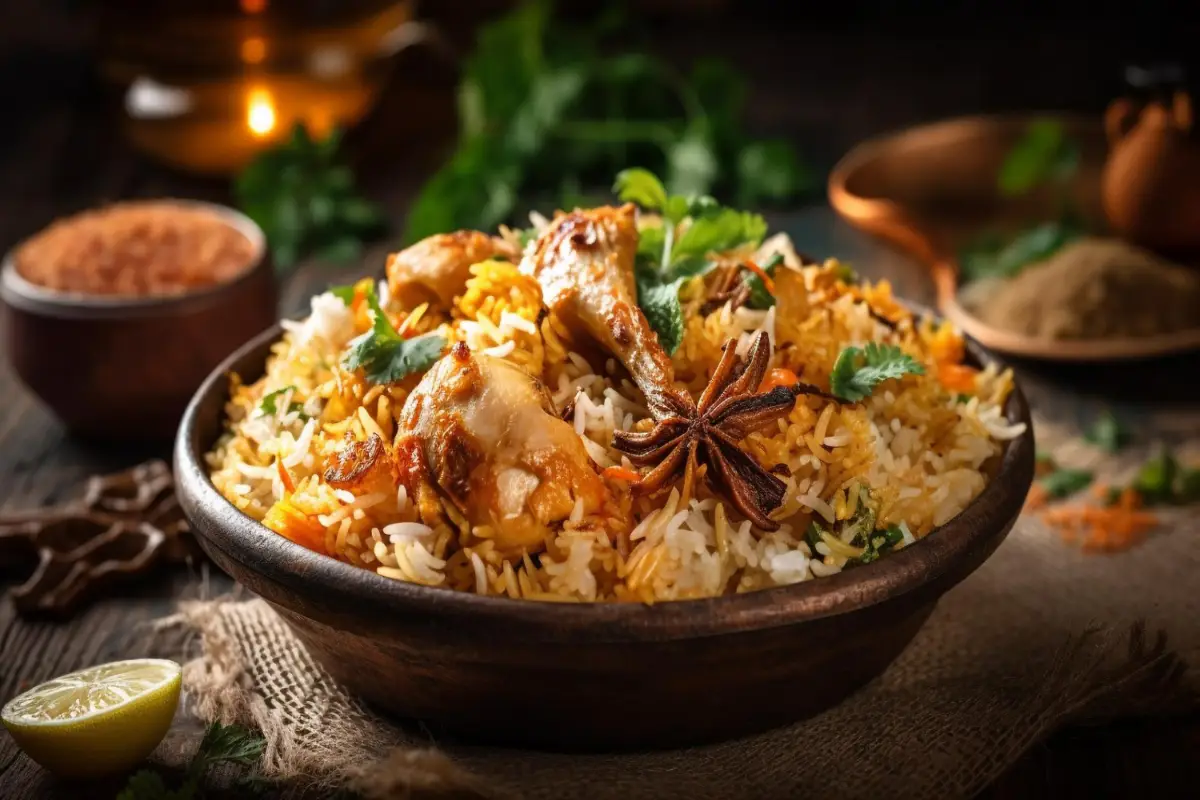Chicken Biryani, a dish celebrated worldwide, is much more than a sumptuous meal. It’s a rich blend of aromatic spices and tender chicken, each bite telling a story of ancient traditions and cultural confluence. This guide, “Chicken Biryani Unveiled: Secrets to the Perfect Dish,” invites you on a journey to explore the secrets behind crafting the perfect Biryani. From traditional techniques to modern twists, we’ll guide you through making this beloved dish, ensuring every flavor and aroma is captured in your kitchen. Join us as we delve into the essence of Chicken Biryani, a culinary masterpiece that bridges past and present.
The History and Origins of Chicken Biryani
Chicken Biryani’s journey begins in the royal kitchens of the Indian subcontinent, a dish born out of the fusion of Persian pilaf and Indian spices. Legend has it that this culinary masterpiece was a favorite among Mughal emperors, who appreciated the intricate blend of flavors and the artful layering of ingredients. As the Mughal Empire expanded, so did the popularity of biryani, spreading across the Indian subcontinent and adapting to local tastes and ingredients.
The dish’s essence lies in its versatility and adaptability. Each region added its signature touch, from using local spices in Hyderabad to adding coastal flavors in Kerala. This adaptability has allowed Chicken Biryani to evolve into numerous variations, each telling the story of its origin through taste and aroma.
Chicken Biryani is not just a dish; it’s a celebration of diversity, a testament to the rich cultural tapestry of the Indian subcontinent. Today, it continues to be a symbol of unity and celebration, enjoyed by millions around the world, regardless of culture or background.
Decoding the Ingredients
At the heart of Chicken Biryani lies a harmonious blend of ingredients, each contributing its unique flavor and aroma to create the dish’s signature complexity. Here’s a closer look at the essential components:
- Chicken: The star ingredient, usually marinated in a mixture of yogurt and spices to tenderize the meat and infuse it with flavors.
- Rice: Long-grain Basmati rice is preferred for its fragrance and ability to remain separate and fluffy after cooking.
- Spices: A symphony of spices, including cardamom, cinnamon, cloves, and bay leaves, are used to impart depth and warmth. Ground spices like turmeric, chili powder, and garam masala add color and heat.
- Herbs and Aromatics: Fresh mint, cilantro, green chilies, ginger, and garlic add freshness and a kick of flavor.
- Yogurt: Acts as a marinade base for the chicken, tenderizing it and adding a slight tang.
- Saffron and Milk: For coloring and aroma, saffron strands soaked in warm milk are sprinkled over the rice, giving the biryani its iconic golden hue.
- Ghee or Oil: Used for cooking, ghee adds a rich, nutty flavor, enhancing the overall taste.
Understanding these ingredients and their roles can elevate your Chicken Biryani from good to unforgettable, blending tradition and taste in every bite.

Step-by-Step Recipe to the Perfect Chicken Biryani
Creating the perfect Chicken Biryani is an art that balances flavor, aroma, and texture. Here’s a detailed recipe to guide you through each step of this culinary masterpiece.
Ingredients:
- 2 cups Basmati rice
- 1 lb chicken, cut into pieces
- 1 cup yogurt
- 2 large onions, thinly sliced
- 2 tomatoes, chopped
- 1/4 cup cooking oil or ghee
- 1 tablespoon ginger-garlic paste
- 2 green chilies, slit
- 1/2 cup fresh cilantro leaves, chopped
- 1/2 cup fresh mint leaves, chopped
- Spices: 2 bay leaves, 4 cloves, 4 green cardamoms, 1-inch cinnamon stick, 1 teaspoon turmeric powder, 2 teaspoons garam masala
- Salt, to taste
- Saffron strands soaked in 1/4 cup warm milk
- Water, as needed
Instructions:
- Prep the Rice: Rinse the Basmati rice until the water runs clear. Soak in water for 30 minutes, then drain.
- Marinate the Chicken: Mix the chicken pieces with yogurt, half of the ginger-garlic paste, half of the chopped mint and cilantro, turmeric powder, 1 teaspoon garam masala, and salt. Let it marinate for at least 1 hour.
- Fry the Onions: Heat oil or ghee in a large pot. Add the sliced onions and fry until golden brown. Remove half for garnishing later.
- Cook the Chicken: In the same pot, add the remaining ginger-garlic paste and green chilies. Sauté for a few minutes. Add the marinated chicken, tomatoes, and cook until the chicken is tender.
- Cook the Rice: Boil water in a separate pot, add the soaked rice, and cook until it’s 70% done. Drain the rice.
- Layer the Biryani: On the cooked chicken, layer the cooked rice, fried onions, remaining mint, cilantro, and sprinkle the saffron milk.
- Dum Cooking: Cover the pot with a tight lid or seal with dough. Cook on low heat for 20-25 minutes to allow the flavors to meld.
- Serve: Gently fluff and mix the biryani before serving. Garnish with the reserved fried onions.
Enjoy your Chicken Biryani with a side of raita or salad for a complete, flavorsome meal.
Expert Tips for the Perfect Biryani Every Time
Crafting the perfect Chicken Biryani is an art that requires understanding the nuances of each ingredient and technique. Here, we delve into expert tips divided into key segments for clarity and ease of reading.
Quality of Ingredients
- Choice Matters: The selection of Basmati rice and chicken significantly affects the final taste. High-quality, long-grain Basmati rice is preferred for its aroma and texture, while fresh, organic chicken enhances the dish’s flavor.
Marination Mastery
- The Foundation: Marinating the chicken overnight in spices and yogurt is crucial for tenderizing the meat and enriching it with flavors, laying a flavorful foundation for the biryani.
Achieving Perfect Rice Texture
- Precision Cooking: Cooking the rice to 70% doneness ensures it remains fluffy and separate when layered with the chicken, avoiding a mushy outcome.
Spice Balance
- Harmony of Flavors: Balancing the spices is key. Using fresh spices in moderation allows each one to contribute to the dish’s complexity without overwhelming it.
Layering Technique
- Art of Assembly: Proper layering is essential for a successful biryani, creating a steamy environment for the rice and chicken to cook perfectly together.
The Dum Process
- Gentle Simmering: The ‘Dum’ or slow-cooking method under a tightly sealed lid is pivotal, allowing the flavors and aromas to meld beautifully.
Importance of Resting Time
- Flavor Infusion: Allowing the biryani to rest after cooking helps the flavors to settle and the steam to distribute evenly, enhancing taste and aroma.
Presentation and Garnish
- The Final Touch: Garnishing with fried onions, fresh herbs, and saffron-infused milk not only makes the biryani visually appealing but also adds layers of flavor.
By following these segmented expert tips, you’re well on your way to mastering the art of Chicken Biryani, ensuring each serving is a culinary masterpiece.
Variations Across Regions
Chicken Biryani, while universally beloved, boasts an array of regional variations that reflect the diverse culinary landscapes of its origins. Each version brings its own unique twist, incorporating local flavors and traditions into this classic dish.
The Richness of Hyderabadi Biryani
Firstly, Hyderabadi Biryani stands out for its rich and aromatic preparation. Cooked with a blend of marinated chicken and partially cooked rice, sealed, and slow-cooked (Dum style), it epitomizes the delicate balance of flavors that biryani is known for.
The Spicy Touch of Chettinad Biryani
Moreover, the Chettinad Biryani from Tamil Nadu introduces a spicier palette, utilizing a generous amount of black pepper and coconut, which adds a distinctive taste and aroma, showcasing the region’s love for bold flavors.
The Fragrant Kolkata Biryani
Additionally, Kolkata Biryani takes a subtler approach, known for including boiled eggs and potatoes along with the chicken. It’s lighter on spices but rich in aroma, reflecting the city’s historical influences and culinary evolution.
The Unique Malabar Biryani
Conversely, Malabar Biryani from Kerala is famous for its distinct taste, achieved by cooking the chicken and rice together with a variety of spices and finishing it with a touch of rose water or saffron, offering a feast for the senses.
These regional variations not only highlight the versatility of Chicken Biryani but also celebrate the rich tapestry of cultures and traditions that have shaped this dish. Exploring these different styles provides a deeper appreciation for the complexity and adaptability of biryani, making it a true culinary treasure.
Pairings and Side Dishes
To complement the rich flavors of Chicken Biryani, selecting the right pairings and side dishes is crucial. These additions not only enhance the dining experience but also balance the meal’s flavors and textures.
Refreshing Raita
First and foremost, a cooling raita, made with yogurt, cucumber, and mint, serves as the perfect counterbalance to the spiciness of the biryani. Its refreshing taste cleanses the palate and soothes the heat, making each bite of biryani more enjoyable.
Savory Salan
Additionally, a spicy and tangy Mirchi ka Salan (chili curry) or Bagara Baingan (eggplant curry) can add a delightful contrast. These Hyderabadi specialties, with their rich sauces, complement the biryani’s complex flavors, adding depth to the meal.
Crispy Pappadams
Moreover, crispy pappadams or papads offer a crunchy texture that contrasts beautifully with the soft, fragrant rice and tender chicken, adding an element of surprise to the dining experience.
Fresh Salad
Furthermore, a simple fresh salad, dressed lightly with lemon juice and salt, can cut through the richness of the biryani. It provides a refreshing and healthy addition to the meal, balancing out the indulgence.
Sweet Desserts
Finally, ending the meal with a sweet dessert like Gulab Jamun or Rasmalai can round off the dining experience beautifully. The sweetness of these desserts complements the savory notes of the biryani, leaving a memorable aftertaste.
Incorporating these pairings and side dishes not only elevates the Chicken Biryani experience but also turns it into a well-rounded, satisfying meal. Whether you’re hosting a dinner party or enjoying a quiet meal at home, these accompaniments are sure to impress.
Nutritional Information and Healthier Alternatives
Understanding the nutritional aspects of Chicken Biryani and exploring healthier alternatives can help you enjoy this beloved dish without compromising on health.
Nutritional Breakdown
Chicken Biryani is rich in proteins and carbohydrates, providing ample energy. The chicken contributes high-quality protein, while the rice offers carbohydrates. However, it’s also worth noting that biryani can be high in fats, particularly if prepared with generous amounts of ghee or oil.
Healthier Alternatives
To make a healthier version of Chicken Biryani:
- Opt for lean cuts of chicken to reduce fat content.
- Use brown rice or quinoa instead of white Basmati rice to increase dietary fiber.
- Reduce the amount of ghee or oil and consider using heart-healthy oils like olive oil.
- Increase the quantity of vegetables in the dish to boost its vitamin, mineral, and fiber content.
By making these adjustments, you can create a Chicken Biryani that’s not only delicious but also more aligned with a health-conscious diet.

Chicken Biryani is more than just a dish; it’s a celebration of flavors, traditions, and the art of cooking. By following the steps and tips outlined in this guide, you’re well-equipped to create a Chicken Biryani that will impress any palate. Remember, the key to a great biryani lies in patience, quality ingredients, and the love with which it’s prepared.
Further Reading
For more culinary adventures and to explore other healthy and delicious recipes, check out these links:

